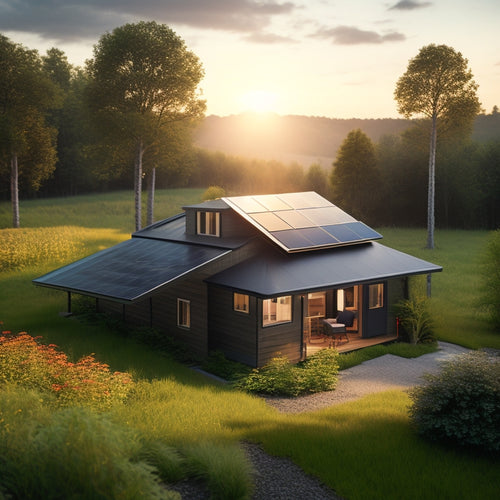
Rural Solar Installations Benefit Remote Communities in 3 Ways
Share
Rural solar installations benefit remote communities primarily through cost-effective energy, sustainable resources, and low maintenance requirements. By generating your electricity, you greatly cut energy expenses and enhance financial stability. Solar power promotes energy independence, reducing reliance on fossil fuels and ensuring a predictable energy supply. Additionally, these systems require minimal upkeep due to their durable designs, allowing you to allocate resources elsewhere. This shift not only encourages local job creation but also enhances technical skills in the community. You might find it worthwhile to investigate how these elements interplay to shape a sustainable future for your area.
At a Glance
- Solar installations significantly reduce energy expenses, allowing remote communities to allocate funds to essential services like education and healthcare.
- Government incentives lower initial installation costs, making solar technology more accessible for rural properties.
- Utilizing solar energy promotes energy independence, reducing reliance on traditional power sources and enhancing fiscal responsibility.
- Solar power creates sustainable local job opportunities, fostering skill development within the community.
- With lower maintenance requirements, solar systems ensure long-term reliability and consistent savings for rural residents.
Cost-Effective Energy Solution
If you're considering solar installations for your rural property, you'll find that they can considerably reduce your energy expenses.
Additionally, the integration of solar panels not only provides cost savings but also creates opportunities for additional income streams through agricultural activities.
With various government incentives available, the initial investment becomes more manageable, enhancing the overall cost-effectiveness of your energy solution.
Analyzing these financial benefits can lead you to a more sustainable and economically viable energy option.
Reduced Energy Expenses
Rural solar installations offer a significant reduction in energy expenses, making them a cost-effective energy solution for many households. By utilizing the sun's energy, you can generate your own electricity, drastically lowering your reliance on traditional power sources. This shift not only cuts monthly energy bills but also provides long-term savings, allowing you to allocate funds toward other important aspects of life, like education or healthcare.
Effective energy budgeting becomes possible as you gain more control over your energy consumption. With solar panels, you're likely to see a stable or even decreasing energy expense over time, easing the burden on your financial planning. You can predict your energy costs more accurately, which helps you create a more sustainable financial future.
Moreover, the initial investment in solar technology can yield substantial returns through decreased utility payments. With the increasing efficiency of solar panels, many households find they can recoup their investment within just a few years.
Embracing solar energy not only frees you from unpredictable price hikes but also enables you to take charge of your financial destiny. Making the switch to solar is a proactive step toward energy independence and fiscal responsibility.
Government Incentives Available
Taking advantage of government incentives can greatly enhance the cost-effectiveness of rural solar installations. Various federal programs offer tax credits that can notably reduce your initial investment. For instance, the Investment Tax Credit (ITC) allows you to deduct a substantial percentage of your solar installation costs from your federal taxes, making the change more affordable.
Additionally, investigate grant opportunities specifically designed for renewable energy projects. These funding sources can provide financial assistance to initiate your solar installation, easing the financial burden on your community.
Local partnerships often play a vital role in accessing these incentives, as collaborating with organizations or government entities can reveal additional resources and knowledge.
Community initiatives, such as solar cooperatives, can further amplify the benefits of energy subsidies, allowing you to pool resources with neighbors for better pricing and installation services.
By leveraging these incentives, you not only reduce costs but also contribute to energy independence and sustainability in your rural area.
Sustainable Energy Source
When you consider sustainable energy sources, solar power stands out due to its renewable nature and widespread accessibility.
This technology not only provides a reliable energy alternative but also contributes to greatly reduced energy costs over time.
With approximately 173,000 terawatts of solar energy reaching Earth daily, the potential for utilizing this abundant resource is immense, especially when considering state-of-the-art renewable energy solutions for off-grid systems.
Renewable Energy Accessibility
Access to renewable energy resources is vital for promoting sustainable development, particularly in rural areas where traditional energy infrastructure may be lacking. When you adopt renewable energy, you're not just tapping into a sustainable source; you're also nurturing energy equity. This means that everyone in the community can access clean energy, regardless of their economic status, which is fundamental for reducing disparities.
Community encouragement is another significant benefit of renewable energy accessibility. By implementing solar installations, communities can take control of their energy sources, breaking free from dependence on costly, unreliable systems. This independence enhances resilience against fluctuating energy prices and supply disruptions, allowing you to focus on developing local economies and improving quality of life.
Additionally, with renewable energy, you're investing in technologies that can be maintained and operated by local residents. This not only creates jobs but also builds technical skills within the community, promoting innovation and self-reliance.
Essentially, renewable energy accessibility paves the way for a more equitable, enabled, and sustainable future, enabling rural communities to thrive on their terms.
Reduced Energy Costs
Many rural communities find that adopting solar installations markedly reduces energy costs. By utilizing solar power, you can achieve significant energy efficiency, which translates to lower monthly utility bills. Traditional energy sources often come with fluctuating prices and hidden fees, but with solar, you gain predictability in your energy expenses. This financial stability enables your community to allocate resources towards other essential services or projects.
Furthermore, solar installations can lead to reduced dependency on fossil fuels, which not only lowers costs but also aligns with sustainable practices. As you adopt this renewable energy source, you're not just cutting expenses; you're actively participating in community enhancement. Local investments in solar infrastructure create jobs and stimulate the economy, ensuring that the benefits of energy savings are felt throughout the community.
In addition, the initial investment in solar technology often comes with incentives and financing options, making it more accessible than you might think. Over time, the reduction in energy costs can help offset initial expenditures, leading to long-term savings.
Embracing solar energy consequently enhances both economic resilience and environmental sustainability, allowing your community to enjoy the freedom and independence that comes with self-sufficiency.
System Components Overview
To successfully implement a rural solar installation, you need to understand the key system components that make it efficient and functional. This includes solar panels, inverters, and battery storage systems, all of which play vital roles in energy generation and storage.
Lithium-ion batteries are preferred for their high energy density and long lifespan, making them an excellent choice for rural applications.
Additionally, grasping the essentials of the installation process guarantees that you maximize the system's performance and longevity.
Key System Components
Understanding the key system components of rural solar installations is vital for optimizing energy production and ensuring reliability.
First, you'll need to choose the right solar panel types. Monocrystalline panels are known for their efficiency and space-saving design, while polycrystalline panels offer a more affordable option, albeit with slightly lower efficiency. Bifacial panels can also be advantageous, capturing sunlight on both sides for increased energy generation.
Next, inverter technology plays a vital role in converting the direct current (DC) generated by solar panels into alternating current (AC), which is necessary for powering your home or community.
String inverters are common for smaller setups, but if you're looking to maximize performance, consider microinverters or power optimizers, which allow for individual panel monitoring and can enhance energy output in partially shaded conditions.
Installation Process Essentials
When commencing a rural solar installation, grasping the essentials of the installation process is essential for guaranteeing peak performance and longevity. Understanding the key components and their interactions can help you maneuver common installation challenges effectively.
Engaging the community throughout the process not only encourages support but also promotes local knowledge sharing, enhancing the overall installation experience. Below is a summary of important system components and their roles:
| Component | Function |
|---|---|
| Solar Panels | Capture sunlight and convert it to electricity. |
| Inverter | Converts DC electricity to AC for home use. |
| Battery Storage | Stores excess energy for use during low production times. |
Each of these components plays a significant role in the system's efficiency. By addressing installation challenges early and promoting community engagement, you'll guarantee that your solar installation meets the unique needs of your rural setting. This approach not only enables you but also strengthens the community's commitment to sustainable energy solutions.
Selecting Based on Energy Demand
To effectively select a solar installation for your rural setting, you need to assess your local energy needs first.
Understanding your energy consumption patterns helps you match the solar supply with your demand accurately. This alignment is essential for maximizing efficiency and ensuring a reliable power source for your home or business.
Conducting thorough load calculations can provide information into your total wattage requirements, allowing for a customized system that optimizes performance and sustainability.
Assessing Local Energy Needs
How can you accurately assess the energy needs of a rural community before implementing solar installations? Start by engaging with the community to understand their specific energy demands. Community engagement is crucial; it helps you gather information on daily usage patterns, peak demand times, and any unique local needs. Conduct surveys or hold meetings to discuss these aspects openly, guaranteeing everyone has a voice.
Next, prioritize energy education. Inform residents about energy consumption, efficiency practices, and the potential benefits of solar energy. This education can lead to more informed decisions and help you gauge their willingness to adopt solar solutions.
Additionally, analyze historical energy data if available. Look for trends in energy consumption to predict future demands accurately. This data-driven approach will help you identify the necessary solar capacity and optimize the design of the installation.
Lastly, consider seasonal variations and the impact of local industries. Understanding these factors guarantees that your solar installation aligns closely with the community's changing energy needs, ultimately contributing to energy independence and sustainability.
In this way, you strengthen the community while laying the groundwork for successful solar integration.
Matching Supply With Demand
While understanding a rural community's energy needs is essential, matching supply with demand is equally important for the success of solar installations. You must analyze the community's energy consumption patterns to guarantee that the solar energy generated aligns with daily and seasonal demands. By doing this, you can achieve supply optimization, which maximizes the efficiency of your solar system.
First, assess the community's peak energy usage times. This information helps you determine the size of the solar installation required. You'll also want to take into account energy storage solutions, such as batteries, to manage excess energy produced during sunny days. This way, you're prepared for periods of low sunlight or increased demand.
Next, regularly monitor energy consumption and adjust your solar systems accordingly. If you notice a change in energy usage—perhaps due to new appliances or changes in community habits—you'll need to adapt the supply. This proactive approach guarantees that the solar installation remains effective and reliable.
Ultimately, successfully matching supply with demand enables rural communities, providing them with energy independence and the freedom to thrive sustainably.
Lower Maintenance Requirements
When you consider rural solar installations, one significant advantage is their lower maintenance requirements.
With fewer moving parts and sturdy designs, these systems often lead to reduced operational costs over time.
This reliability not only enhances efficiency but also allows you to allocate resources more effectively.
Reduced Operational Costs
Reduced operational costs in rural solar installations stem largely from their lower maintenance requirements, which contribute to overall efficiency and sustainability. When you choose solar energy, you're investing in a system designed to minimize upkeep. Unlike conventional energy sources that often require frequent repairs and adjustments, solar panels typically need minimal intervention once installed. This translates directly into operational savings for your community.
The energy efficiency of solar technology also plays a vital role. With fewer moving parts and the ability to utilize sunlight directly, these systems operate at a high level of reliability. You won't have to worry about the constant wear and tear associated with traditional energy infrastructures, which can drain resources and budgets.
Additionally, the reduced need for maintenance means you can allocate funds elsewhere—be it for community projects, education, or other services that enhance your quality of life.
Embracing solar energy not only gives you the ability to take control of your energy future but also nurtures economic resilience through consistent operational savings. In this way, rural solar installations become a viable solution, enabling you to thrive while minimizing costs.
Frequently Asked Questions
How Do Rural Solar Installations Impact Local Job Creation?
Rural solar installations encourage local job creation by providing job training opportunities, enhancing skill development. This economic enablement allows you to engage in sustainable energy projects, ultimately driving community growth and promoting self-sufficiency in remote areas.
What Incentives Exist for Installing Solar in Remote Areas?
You might not realize it, but federal incentives, tax credits, renewable grants, and installation subsidies can greatly lower costs for solar installations in remote areas, enabling you to adopt clean energy and enhance your community's independence.
Can Solar Power Systems Be Expanded as Community Needs Grow?
Yes, you can expand solar power systems as community needs grow, ensuring community scalability. This flexibility enhances energy independence, allowing you to adapt and innovate, meeting the demands of a changing environment and promoting sustainable practices.
How Do Weather Conditions Affect Solar Energy Efficiency?
Weather conditions greatly impact solar panel performance. Climate variability, like cloud cover and temperature fluctuations, can reduce energy output. To maximize efficiency, you'll need to monitor and adapt your system to changing environmental factors regularly.
What Role Do Batteries Play in Rural Solar Systems?
Batteries in rural solar systems provide essential battery storage, enabling you to capture excess energy during sunny days. This capability enhances your energy independence, ensuring you have power when the sun isn't shining.
Explore More
To sum up, rural solar installations aren't just a trend; they're a lifeline for remote communities. By providing a cost-effective, sustainable energy solution with low maintenance requirements, these systems enable residents to utilize the sun's power for their needs. When selecting components based on energy demand, you're not just investing in technology—you're investing in a brighter, more independent future for your community. Isn't it time to let the sun shine on your energy choices?
Related Posts
-

Top Portable Refrigerators for Camping Adventures
When you're camping, having a reliable portable refrigerator can make all the difference for keeping your food fresh ...
-

Diy Off Grid Solar
By embracing DIY off-grid solar, you can break free from grid dependence, slashing your energy bills by up to 90% and...
-

Key Features of a DC to AC Converter
A DC to AC converter features high efficiency and conversion rates, which reduce energy costs and improve performance...


